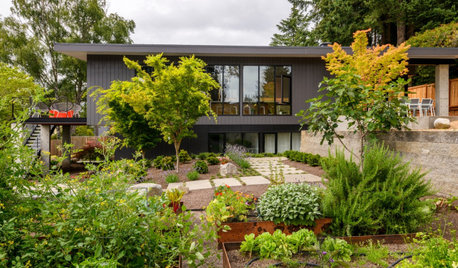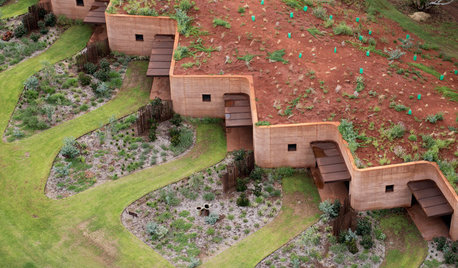Comparing Pumice, Sand, and Turface in Structured Soils
westes Zone 9b California SF Bay
4 years ago
last modified: 4 years ago
Featured Answer
Sort by:Oldest
Comments (19)
Related Discussions
The 'Perfect' Gardening Soil Structure?
Comments (69)Hey ssmd, Boy, its all here. Posts with opinions from everyone. Observations from my chair - adding sand to clay soils is labor intensive, not necessary and further, by itself doesn't work. Humus, Humus, Humus - Mycorrhizae, Mycorrhizae, Mycorrhizae - soil test, soil test, soil test. Products - Soil Secrets Terrapro, 94% REAL HUMUS + helper bacteria and mycorrhizae. Protein Crumblies, balanced food for the Terrapro helper bacteria. Liquid Earth Nectar and Earth Ambrosia once a month during the growing season, which gave more humus and biologics. All wild plants (I hate the term weeds) were pulled and dropped creating my own mulch. That has been my program for my 2010 and 2011 start up gardens on two separate locations here in Cochise, Arizona. I put these materials on top on my ph 8.8 and ph 7.3 concrete soils, watered them in, shallow planted and applied a 1" mulch. I did no tillage of any kind and no raised beds! All beds were at ground level. Virtually all of the foods grown had flavor that I can't remember tasting in any of my gardens since 1977. Some were close, but not as good. In 2010 a professional documentary film crew spent a day in the garden and we shot a how to and demonstration film titled, "The Double Victory Garden". You can get it on the web but I decided not to market it myself because it did have some minor errors that I wanted to correct. I am anal about these things. The 94% humus (confirmed by lab analysis) in Terrapro primes the soil pump providing a powerful negative charged energy field which attracts and holds the positive charged nutrients, Ca, Mg, K. etc. mentioned in the "Soil test - Why do it? and the Humus (OOW) threads". One molecule of "Supramolecular" Humus can attract and hold for plant use over 10,000 water molecules! The negative charge (CEC)of sand(least), silt (more), and clay (most) on the CEC (Cation Exchange Capacity) scale rarely is over 30. Compost generally runs 25 to 75 (if well made) and Supramolecular Humus is up to 250! The compost provides slow steady release plant food and that is its value. It only provides a max of 5% humus, that is what the new research proves. If you doubt this, have your compost tested and I don't mean an organic matter test, I mean a HUMUS test! The more alkaline the soil is, the higher the CEC of the humus - No need to try to change the ph, the humus adjusts to it whatever it is. Humus is the great fixer - It adds body to sandy soils and with Ca and Mg will aggregate and open up heavy clay soils so they can breathe. Universal fix-all! Nature can make ideal soil as mentioned but we have to provide the right inputs. When I started, I had to stand on my soil probe to get in an inch. 3 months into the season I could sink it in over a foot but this was in the beds which had received drip irrigation. A month ago when the soil in the beds was dry, the probe still easily went in over a foot! That impressed me. Jon, awesome garden! It obviously reflects your dedication and your hard work. I am not a market gardener, I am a researcher, experimenter and grow for the family I live with though I have sold some excess. Please visit my website, thedoublevictorygarden.com and Soilsecrets.com for the full story. On my site I have a before and after soil analysis for the 2011 garden. You might want to take a look. Blessings to us all....See MoreLithops Soil Mix & Sand Topping
Comments (9)What is coral sand? Is that crushed coral? That would be almost pure calcium carbonate/ limestone. If so, it should be used sparingly as any acidic soil component may cause liberation of lots of calcium. Take some of the sand, and place it in a cup and add some vinegar. If it starts to fizzle, then you have good old limestone. It should be used in small amounts since the high surface area of the particles makes it pretty active. It can make your mix too alkaline, although the chemistry is complicated so who knows. x...See MoreFinding crushed Granite/ 6/20 sand small lava rock or pumice i
Comments (7)Tom I was checking my email throughout the day and I didn't know if you got my email address. I am already back from Largo, and I was at Haines City before that. I was hoping to have gotten your phone# while I was up there so I could have stopped by. I bought 8 bags of the 6/14 silica sand so at least I have something, but I still would prefer the Gran-I-Grit. Tom, how long is the wait once you order it from that feed store? Is the product actually Gran-I-Grit, or some different named stuff, and is it similar in size and structure? I still might take you up on the offer for the grit when I stop back up that way. We need to exchange emails again if you nerver got my email....See MoreComparing a Succulent in Gritty Mix Against Commercial Cactus Soil
Comments (5)@meanom most people here mix gritty mix as equal parts of: * granite stone that is 1/4" to 3/8" (no fines or sand) * turface MVP that is filtered, and many people here "cheat" and filter out only particles smaller than 1/16" * bark filtered 1/4" to 3/8". Fortunately, I found a local supplier that prefilters to 1/4" I would recommend using some root hormone to get the roots growing into that medium. Then fertilize maybe starting two weeks later....See Morecactusmcharris, interior BC Z4/5
4 years agowestes Zone 9b California SF Bay thanked cactusmcharris, interior BC Z4/5westes Zone 9b California SF Bay
4 years agolast modified: 4 years agowestes Zone 9b California SF Bay
4 years agolast modified: 4 years agowestes Zone 9b California SF Bay
4 years agolast modified: 4 years agotropicofcancer (6b SW-PA)
4 years agowestes Zone 9b California SF Bay thanked tropicofcancer (6b SW-PA)tropicofcancer (6b SW-PA)
4 years agolast modified: 4 years agowestes Zone 9b California SF Bay thanked tropicofcancer (6b SW-PA)westes Zone 9b California SF Bay
4 years agolast modified: 4 years agotropicofcancer (6b SW-PA)
4 years agolast modified: 4 years agowestes Zone 9b California SF Bay thanked tropicofcancer (6b SW-PA)tropicofcancer (6b SW-PA)
4 years agowestes Zone 9b California SF Bay thanked tropicofcancer (6b SW-PA)westes Zone 9b California SF Bay
4 years agolast modified: 4 years agowestes Zone 9b California SF Bay
4 years agolast modified: 4 years agotropicofcancer (6b SW-PA)
4 years agowestes Zone 9b California SF Bay thanked tropicofcancer (6b SW-PA)westes Zone 9b California SF Bay
4 years agotropicofcancer (6b SW-PA)
4 years agolast modified: 4 years agowestes Zone 9b California SF Bay thanked tropicofcancer (6b SW-PA)
Related Stories

FARM YOUR YARDHow to Get Good Soil for Your Edible Garden
The nutrients in your soil feed the plants that feed you. Here are tips on getting it right — just in time for planting season
Full Story
GARDENING GUIDESGardening Solutions for Heavy Clay Soils
What’s a gardener to do with soil that’s easily compacted and has poor drainage? Find out here
Full Story
GARDENING GUIDESNew Ways to Think About All That Mulch in the Garden
Before you go making a mountain out of a mulch hill, learn the facts about what your plants and soil really want
Full Story
GARDENING GUIDES10 Ways to Make Your Garden More Productive
Maximize your garden’s growth and output by building healthy soil, expanding growing space and collecting rainwater
Full Story
HOMES AROUND THE WORLDWorld of Design: A Cool Place to Call Home
Aussie architects snap up a third global award for their innovative take on workers’ apartments on a remote cattle ranch
Full Story
FARM YOUR YARDHow to Grow Vegetables in Containers
Get glorious vegetables and fruits on your patio with a pro’s guidance — including his personal recipe for potting mix
Full Story
LANDSCAPE DESIGNNatural Swimming Pools: More Beauty, No Chemicals
Keep your skin and the environment healthy with a pool that cleans itself, naturally
Full Story
GREEN BUILDINGHouzz Tour: See a Concrete House With a $0 Energy Bill
Passive House principles and universal design elements result in a home that’ll work efficiently for the long haul
Full Story
EARTH DAY5 Ideas for a More Earth-Friendly Garden
Consider increasing the size of garden beds, filtering rainwater and using plants to reduce energy use
Full Story
MOST POPULARHow to Add a Backyard Shed for Storage or Living
Need a home office, a playspace or extra room for your stuff? Learn about off-the-shelf, prefab and custom sheds
Full Story





tropicofcancer (6b SW-PA)